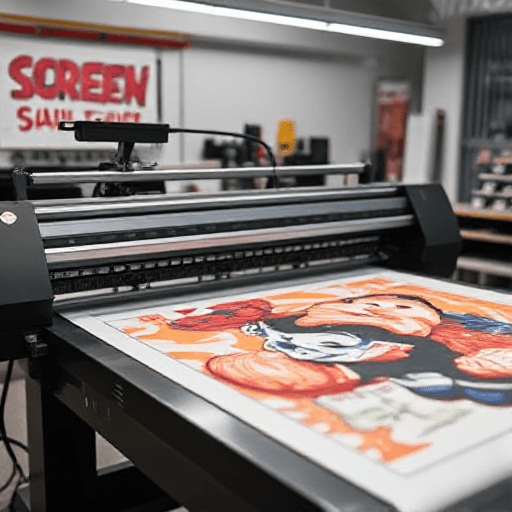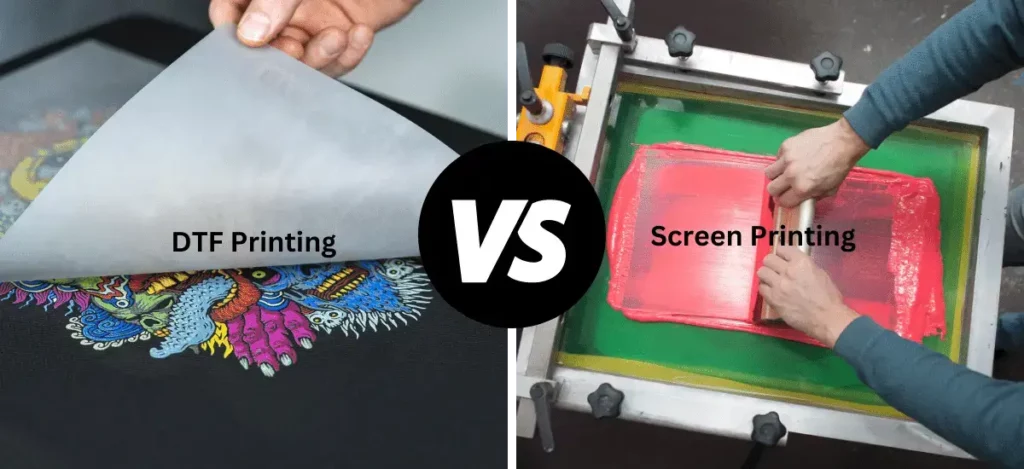When designing prints on clothing and other merchandise, both screen printing and Direct to Film (DTF) printing provider the two most used methods in the printing industry. Each method contains its advantages and disadvantages, making it difficult to make the right choice for businesses, hobbyists, and DIY enthusiasts. Screen printing is better than DTF, but actually, what is the comparison between both? This article would expose you to the advantages and disadvantages of each technique so that you can choose the best one suited for your need.

Table of Contents
What is Screen Printing?
Screen printing or silkscreen printing is one of the oldest and very popular ways of transferring designs onto fabrics, paper, and other media. This whole method comprises creating a stencil or screen of the design, which will then apply ink to the printing surface. The whole design will need a different screen for every color. Hence, it is a very suitable process for designs with limited colors.
Process of Screen Printing
- Making the Screen: A light-sensitive emulsion that can be exposed to UV light is coated on a mesh screen, which, when burned, shows the design on the screen.
- Setting Up the Design: Ink is filled into the screen that has been placed on the piece of clothing, forcing its way through the mesh transferring to the fabric.
- Curing: The above steps are then heat set with the ink for final results that are durable and long-lasting.
What is DTF Printing?
DTF printing, or direct to film, is the latest method of transferring ideas into clothes. It includes printing your designs on a special film with special inks that transfer onto fabrics using heat and pressure.
Process of DTF Printing
- Print out the Design: The design will first be printed onto a film sheet by DTF printers with CMYK inks.
- Apply Adhesive Powder: After printing, the adhesive powder is applied to the ink while it is still wet.
- Cure the Design: Melt the adhesive powder through heat press for adhesion of the design to the print.
- Transfer to Garment: Finally, the garment is subjected to heat pressing for the design transfer.
Key Differences Between Screen Printing and DTF
Evaluating the proper way both coincides with your business needs and project goals is important when deciding between screen printing and DTF printing. Below, we break down the key differences to help you in making an informed decision.
Quality of Print
Screen Printing:
- High-quality prints are produced; excellent vibrant colors highly saturated.
- Ideal for localized color designs as each color requires a separate screen.
- The process may be ineffective on fine lines for highly detailed designs.
DTF Printing:
- Is capable of phenomenal detail, including photorealistic images with gradients.
- Complexity or multiple colors will not require a number of screens.
- Variable print quality depending largely on the printer and the film.
Cost Efficiency
Screen Printing:
- Best with complex orders but setup can be pretty expensive for smaller runs.
- Higher the quantity printed, cheaper is the cost per item. Generally very effective when printing large amounts of an identical design.
DTF Printing:
- Cost effective for small runs, since no set-up costs involved.
- However, ink and film may be slightly more expensive for large quantities compared to screen printing.
Durability
Screen Printing:
- Lasts long and lasts more because of proper curing methods.
- Ink becomes part of the fabric, hence not crack or fade on the course of time.
DTF Printing:
- It has a good durability, but still, it does not stand the test of time as long as screen printing, especially when machine washed often.
- Sometimes, the adhesive layer used in DTF printing causes the print to crack or peel over time.
Ease of Setup
Screen Printing:
- Setup is tedious and requires specialized machinery.
- Preparation is needed for each color, which prolongs the setup.
- More space for equipment and screen setup is required.
DTF Printing:
- Setups are easy and quick, given that there are no stencils to be made or multiple screens to prepare.
- DTF printers could occupy a little more space than the screen printing machine.
Production Speed
Screen Printing:
- Production speeds are slow to moderate, especially for multi-color designs.
- Preparing a new screen for every color just adds to the slowness.
DTF Printing:
- Faster than screen printing, particularly when using many colors.
- On the same day, you can print and transfer the design, making it great for small runs and quick turnaround.
Design Versatility
Screen Printing:
- Best for basic designs with limited colors.
- Not suitable for detailed or intricate artworks with gradients.
DTF Printing:
- Offers much more versatility, handling complex designs that contain fine details and full colors.
- Works well on many substrate types: cotton, polyester, and blends.
Pros and Cons of Screen Printing
Pros:
- Durability: The ink seeps into the fabric; hence, prints last long.
- Mass Production: The larger the order, the cheaper the per-item cost.
- Sharp Colors: Screen printing provides outstandingly vivid colors.
- Perfect for Bulk Production: Mass-producing items such as t-shirts, hoodies, and bags is easy with this.
Cons:
- Expensive setup: There are expensive setups and equipment for the creation of screens.
- Color Considerations: Desiring one to select separate dyes for every color could up the costs on multi-color designs.
- Unsuitable for quantifying small orders: Time-consuming and expensive, setup involves being less cost-efficient for small print runs.
Pros and Cons of DTF Printing
Pros:
- Fast Set-Up: Quick set up and best for small runs or custom orders.
- Excellent Quality of Prints: Good quality for printing designs with details, with multi-colors, having gradients.
- No set-up pricing: Need no screens or stencils, making it great for small companies and hobby workshops.
- Versatile material compatibility: Light and dark fabrics, including cotton, polyester, and blends are suitable.
Cons:
- Concerns regarding durability: It may not be as long-lasting when compared with screen printing, particularly after several washes.
- Ink and film costs: Ink and special film costs escalate particularly for bulk.
- Less preferred for larger orders: Good for smaller runs, but for bigger orders, the expense per unit may be higher than that of screen printing.
Which Method is Right for You?
Deciding whether screen printing or DTF printing is better depends on several factors:
- Volume of Orders: For large orders, screen printing is usually a more cost-effective process. For custom or smaller runs, DTF printing is a cheaper, faster, and more economical way to go.
- Complexity of Design: For detailed designs with gradients and fine details, DTF printing really takes the crown; simple, bold designs are what screen printing is good for.
- Durability: If you want prints to be more durable and withstand multiple washes, then go for screen printing. DTF prints are durable but may not last as long as screen-printed designs.
- Turnaround Time: For speedy production, setups and output are much faster in DTF printing, perfect for last-minute orders or small batches.
Conclusion
So, is screen printing better than DTF? The answer all depends on your specific case. If you consider large-volume production with simple designs, screen printing is typically the most reasonable. It is highly resistant to fading and is economically viable for bulk runs in terms of per-unit price. Nevertheless, if working with large orders, intricate designs, or if prompt turnaround is needed, DTF printing may suit your needs better.
Ultimately, both have their reputations, and having an understanding of both will assist you in making the best choice for your venture or artwork.
FAQ: Is Screen Printing Better Than DTF?
What’s the biggest advantage of screen printing over DTF?
Mass production is what screen printing is best adapted for, along with higher durability.
Does DTF printing work on large orders?
DTF printing does better for small to medium runs, while screen printing may turn out cheaper to do for sky-high volume orders.
Which method offers better quality for detailed designs?
DTF printing is best for intricate and detailed designs that truly encompass photorealism and fine lines.
Is screen printing more expensive than DTF?
The screen printing setup costs become lower for large orders, thereby bringing it to just reasoning. DTF is inexpensive for small runs but can be more costly for larger volume orders.
